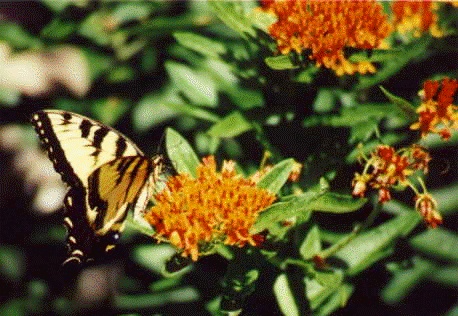  Etheda Jo's Ramblings of a Demented Gardner Or  ~Gardening Like Mama Never Taught Me~ ~Gardening Like Mama Never Taught Me~
  |
  Etheda Jo's Ramblings of a Demented Gardner Or  ~Gardening Like Mama Never Taught Me~ ~Gardening Like Mama Never Taught Me~
  |
 a successful gardener. I am a "wanna-be." God knows that I've tried. I bought all of the books, researched the library, laid out grids, made charts and grafts, everything. I'd had visions of gracious, well-balanced gardens of glorious colors. Gardens for which I'd first don the large exquisite sun hat and the chic gardening gloves, then languidly stroll into, to piddle-n-muse in amidst my abounding flowers...ahhhh. You know, liken unto Mrs. Cleaver? Cleaning house in high heals and pearls? Well, don't you believe it! Gardening is sweaty, dirty work. And it NEVER EVER looks like in does in the magazines. The focal point and very heart of one of my gardens, for example, just died away, leaving this doughnut-looking disaster. So over the years, I've developed my very own Gardener's Master Plan ~Grab a plant that you like, poke it in the dirt, and hope for the best.~ You may be surprised!  I think God looks after my type of gardener. Some of my very best plantings were done totally by accident. For instance, a large purpley cluster of Grape Hyacinths against the pink of some Flowering Pink Almonds; a bank of yellow Mums against a gray rock wall (initially intended as a temporary holding spot for the Mums, glad I simply forgot to move them!); some red Tulips against a mass of variegated green Ajuga. Ajuga and Vinca Minor are two of my favorite ground covers. See illustration below of Impatiens countersunk among purple Ajuga.    Some of your best plants can be found in the wild. Every prepared gardener needs to carry a shovel, jug of water, papertowels, and plastic baggies in the trunk of their car. You never know when you will find a wildflower that needs to be "rescued." I have several small low-blooming Iris from a rocky hillside in Arkansas; a Red Trumpet Vine from a nearby pond; a Blazing Star that a road grader had uprooted; a smidgen of Spiderwort; a small, feathery Fern from Kentucky; a clump of Blue Eyed Grass; a tall, stately, wild Liatris (also known as Snake Root), that stands over five feet tall in among my other Liatris; and, my favorite, Butterfly Weed, or what I've always called Chigger Weed. 

 I had seen a particularly colorful patch near Grove, Oklahoma, so my sister and I took a day off and drove up for a rescue. One Rule: If it seems to be growing on private land, try to find the owner and ask permission. We drove up to the main ranch house and proceeded to explain our request to a ranch hand near the gate. After he heard us out, he told us, "Dig up old weeds all you want, but just don't let my bull out." He sort of shook his head all the way back to the barn, befuddled by the strange ways of women. After much heavy digging, and with a very careful lookout for the bull, we had several large clumps of healthy roots. Now three years later, if only that ranch hand could see, I doubt that he'd still doubt our sanity. That particular clump of orange flowers is large and is the brightest spot in my yard. It is just beautiful and the Butterflies love it! See? (...still haven't seen that bull anywhere, though...)    Every gardener should have an able assistant. I acquired mine last year when my husband brought home a large, lanky, loveable, stray dog that had wandered into his place of work. This dog has a great personality, but, on speed, is rather like a Clydesdale! His previous owner must have kept him confined in a paved area, whereas in our back yard, he discovered his true love - DIRT!! His name is Duke, but a more appropriate name would be Digger Duke, as he considers himself a better gardener than I am. He will lie on his picnic table and watch me with a critical eye, then when I go in the house, he rearranges everything I have done! My garden has taken on a whole new look. One particular flowerbed seemed to be his favorite, but he couldn't decide on a basic design. He dug it completely out on a regular basis. I was hard-pressed just putting the dirt back in, not to mention bulbs, Iris, roots and mangled plant parts. He did leave me a Thank-You gift for my helpful labors, though. Last Spring, I discovered six lovely Gladioli blooming there! There were three salmon-colored ones, and three delicately-shaded pink ones. I have never had Gladiolus in my garden before, so was delighted with his surprise gift! I still have no idea where they came from. He was encouraged by his apparent success, and it urged him on to branch out into pruning. He ignores my Crepe Myrtle and Forsythia, but has trained my Rose of Sharon to resemble a large mushroom, and I now have several "Bonsai" Azaleas. Thank goodness he can't reach my Spirea in the front yard, but he looks at it longingly over the fence.   Iris is good plant for a "wanna-be" gardner. They are hardy and have nice foliage even after they stop blooming. I have several varieties in the back. Plan on a lot of yellow blooms, though. It really doesn't seem to matter what variety you plant, most will be pale yellow in color. I think it's an Iris "rule" or something. Well, except for my all time favorite, Siberian Iris. Long slender stems with delicate blue blooms. They look so fragile, but are hardy and drought resistant. They also multiply quite quickly. When my bed of Siberian Iris in front is in full bloom, people have stopped just to ask what they are.  

 
Another reason that I like them is that they hold color and never turn to yellow Iris. However, I am growing quite fond of yellow. In fact, another of my better achievements in gardening is an almost all-yellow theme - varieties of the Black Eyed Susan and its family. I have acquired several varieties over the years. Some are small and almost ruffled, some saucer size, some a variegated variety - and then comes the Cone Flowers, a small variety, called Yellow Prairie Cone Flower (...yep, you guessed it! I found it by a roadside in Craig County, Oklahoma...).  The large Purple Cone Flower,  or Echinacea, or Echinacea, makes a nice color contrast with the yellow, and I am just now beginning to learn about the medicinal value of this old favorite. Marigolds are another old-fashioned favorite in the yellow hues. Daffodils are a must in anyone's garden - LOTS and LOTS of Daffodils. One tip: Do not trim the foliage back until it has turned completely brown. That is where they get their strength to bloom next spring. I know the leaves can be unsightly when dying back. One suggestion is to just braid them. Yes, I said braid them, just like you would hair. They are neat and tidy that way, and stay out of the way of mowers. However, you may choose to do this under the cover of darkness. I have a non-gardener-type neighbor who watched me braiding away on my Daffodils and informed me that I needed to "get a life."   If you have a shady corner, you can try a shade garden. I have a small collection of Ferns in a shady spot. Ostrich, Painted Lady Fern, and Wild Fern (that I gathered from the woods), a Bleeding Heart and even some Day Lilies. Day Lilies will not bloom very well in deep shade, but the foliage is a nice compliment to the lacy ferns (my Tiger Lily, on the other hand, likes full sun). Also, I planted lots of Hostas. I love my Hostas and there is nothing better for shade planting. You can do a lot with shady parts of the yard. I have a Wisteria arbor on the front of the house that creates a shady entryway. There I grow pots of Caladiums, Impatiens and Mouse's Ear. Wisteria can be a little troublesome, with the constant trimming, but well worth the effort. To the outside of the arbor, I added a little more color with some sun plants, ie., Shasta Daises, Peonies, old fashioned Phlox and a hanging pot of Rose Moss. I greet my guests with flowers (...or with the flower pots anyway...).   Every one who gardens has a failure or two. Mine seems to be with two old fashioned favorites that seem to thrive hardily for everyone else. Actually mine are quite healthy, but they refuse to bloom. Everyone has Hollyhocks, or used to. They bloom so prettily for everyone else, but mine just sit there and pretend to be greenery. To do with the afore-mentioned Wisteria - Over a period of twenty-five years, I have had two separate plantings and never a bloom. I found a solution this year! I wired on several silk wisteria blooms. It looks pretty good really, and it may set them (the hiders?) an example! And, hey, "my" Wisteria is still showing blooms when everyone else's is bare!  So all in all, My garden/yard is not what you would ever compare to a "real" garden. I will never get "Yard of the Month." In fact, it looks sort of seedy most of the time. But, I have a little sign out back that says it all: "One is nearer God's heart in a garden than any place else on Earth."  And who knows? And who knows? Since I have discovered the medicinal properties of Echinacea, I may start an herb garden! (Do you think Chamomile might have a calming effect on my Duke?)  |






 My Genealogy Page
My Genealogy Page



